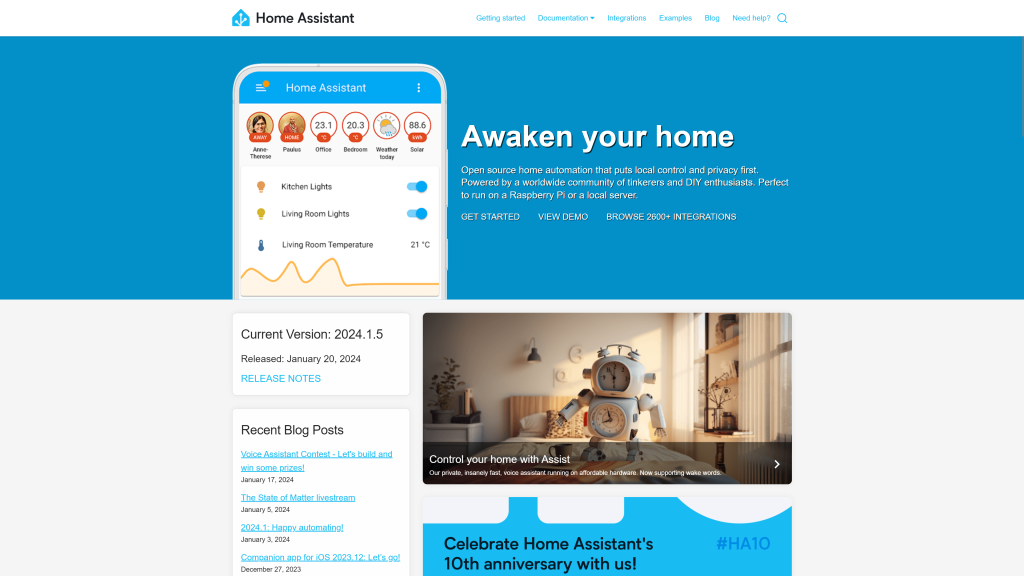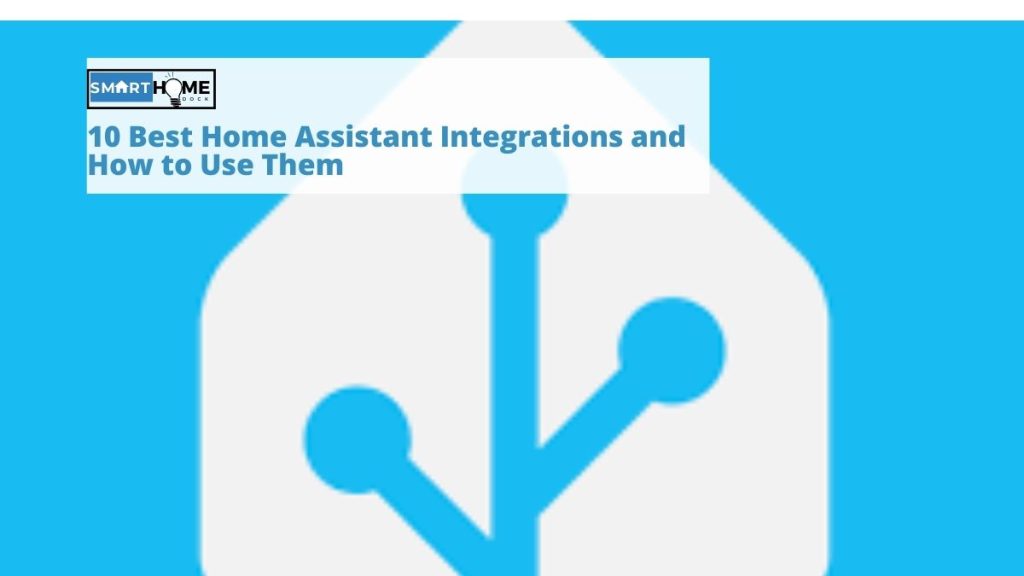We dive into the 10 Best Home Assistant Integrations and How to Use Them.
Join the smart revolution by converting your home into an intelligent home, which you can control remotely from anywhere.
But managing your smart home can be frustrating, especially if you have multiple gadgets that don’t communicate with each other.
Besides this, navigating different apps and interfaces to coordinate your devices can be time-consuming. But the good thing is that you can eliminate this challenge by using a reliable home automation system.
One of the best hubs to integrate all your smart devices into your home is Home Assistant. With Home Assistant, you won’t have to go through each room in your home to turn on and off lights.
Another thing that most people like about Home Assistant is its extensive list of integrations. These integrations are plugins or add-ons that allow Home Assistant to connect with smart devices and services.
These integrations make Home Assistant a powerful and seamless home automation system with extended functionalities.
In this guide, we will look at the best Home Assistant integrations. There are quite a number of them, but we will limit our selection to only ten.
The best thing is that these integrations cover a wide range of smart gadgets and services, including thermostats, lights, sensors, switches, and media players, among others.
What’s more, some of these integrations are open-source and free to use. So, let’s get started.
Adding Integrations to Home Assistant

Before we can look at the best Home Assistant integrations, it will help to understand how to add them to your Home Assistant. Mostly, you need to install and make the necessary changes in the Home Assistant configuration file.
Typically, it involves providing the right configuration details, like API keys, credentials, or device IDs, but note that the configuration process may vary depending on the integration you are implementing.
Successfully setting up these integrations will allow you to use Home Assistant to coordinate the relevant devices and services, receive notifications and alerts, and create automation routines.
The cool thing is that you can manage these integrations from your Home Assistant user interface. So, depending on your needs and preferences, you can add, remove, and configure the integrations with ease.
The Best Home Assistant Integrations
As mentioned earlier, there are quite a number of Home Assistant integrations, but the below ten are the best ones.
1. Z-Wave Integration
If you are looking for a smooth smart home experience, you might need to migrate all your Z-Wave devices, like smart plugs, sensors, door locks, and watches, to Home Assistant.
Z-Wave integration in Home Assistant will empower you to coordinate all these Z-Wave devices from a single platform.
Z-Wave Integration is among the best Home Assistant integrations because of its powerful capabilities, such as the ability to create automation routines and control Z-Wave devices from any location.
For integration to work, you need a Z-Wave controller and Z-Wave integration configuration in Home Assistant.
Also Read, ZigBee vs Z-Wave: Everything You Need to Know
2. Google Assistant Integration
One of our favorite Home Assistant integrations is the Google Assistant integration. It is all about convenience control.
With such an integration, you can easily control most of the devices in your smart home using voice commands from faraway places.
There is no need to learn an app or something like that. All you need to do is tell Google Assistant to open the garage door, turn the lights on, start the robot vacuum, or even arm the alarm.
Home Assistant’s cloud integrations with Alexa or Google Assistant will make any controllable devices in Home Assistant available in your favorite digital voice assistants.
But note that you need a Google Assistant-enabled device, like a smartphone or Google Home.
3. Weather Integration
There are lots of fantastic integrations in Home Assistant that can help you receive weather forecasts. With these integrations, you can receive real-time weather information for your region.
The good thing is that some options provide you with more information than just the temperature of your location.
To set up this type of integration, you need to install and provide your location information. Once you have set up and activated the integration, you can now use your Home Assistant to receive current weather forecasts, conditions, and relevant weather information.
One of the best Home Assistant integrations for weather updates is the National Weather Service (NWS) integration.
The NWS integration is fantastic because it provides percentage chances of precipitation, among other weather forecasting data.
4. MQTT Integration
This is also among the best Home Assistant integrations that you can use to power your smart devices. This lightweight messaging protocol can come in handy if you have lots of IoT applications.
This integration lets you connect to an MQTT broker. You can also subscribe to relevant topics that you intend to receive messages on.
To use the integration, you will require to set up an MQTT broker. After which, you can configure MQTT integration in Home Assistant.
MQTT integration is the engine behind sensors, remote controls, pushbuttons, smart fireplaces, smart switches, and garage door openers, among others.
5. HomeKit Integration
HomeKit is a suitable smart home ecosystem for homes that use a lot of Apple devices. So, HomeKit integration in Home Assistant will enable you to connect other devices in Home Assistant into your HomeKit ecosystem.
The good thing is that it is easy to set up the integration. All you need is an Apple device, such as an iPad or iPhone, and, of course, the HomeKit integration setup in Home Assistant.
After completing the setup, you can then use your iPhone or iPad to coordinate your Home Assistant smart devices. You can use it to control things such as adjusting the thermostat or even turning on or off the lights.
6. Philips Hue Integration
You can control the Philips Hue smart lighting system with Home Assistant. To achieve this, you will require a Philips Hue bridge and, of course, Philips Hue smart lights.
Once you have set up the Hue bridge and lights, you can use Home Assistant to control how the lights work. For instance, you can create a routine that turns on and off lights at specific times.
Philips Hue offers a wide range of smart devices, such as fixtures, lamps, light bulbs, and accessories. Whether you need the best lights for your living room, kitchen, bedroom, bathroom, or backyard, Philips Hue has the perfect light for you.
On top of this, you can find various sizes, shapes, and models of lights that suit your space. And with the help of the Hue app, you can adjust the brightness quickly and easily.
7. Google Cast
If you have several Google Assistant devices in your smart home, you can easily use Home Assistant’s Google Cast integration.
We believe that it is one of the best Home Assistant integrations because it allows you to control several devices at once.
You can easily send text-to-speech messages to multiple devices or even a single device. We believe that it is a great voice feedback mechanism for triggered automations.
For instance, you can use it to warn an illegal intruder into your home that authorities are on the way.
8. Sonos Integration
This is another Home Assistant integration that you can use to control Sonos speakers. To setup the integration, you will need the Sonos integration configuration in Home Assistant as well as a Sonos speaker.
After the setup is complete, you can then use Home Assistant to coordinate your entertainment system. In this case, you will use your Home Assistant to instruct Sonos speakers for actions such as adjusting the volume on a device or playing your favorite playlist.
9. SmartThings
SmartThings is one of the most robust smart home ecosystems. So its integration with Home Assistant will allow you to control a variety of devices, ranging from smart sensors to smart bulbs to leak detectors.
Essentially, SmartThings connect your smart home, making it more simple, safe, and entertaining. But you can enhance this further by bringing everything into Home Assistant.
Also Read, What is a Smart Home? Everything You Need To Know To Get Started in 2024
10. Tasmota Integration
To close our list of the best Home Assistant integrations, we recommend the Tasmota integration. This type of integration in Home Assistant will allow you to link any Tasmota-flashed device to your Home Assistant.
Once you have set up the integration, you can monitor and instruct your Tomato devices from within Home Assistant, customize your home automation setup, and create relevant automation.
Since Tomato firmware allows you to access various devices using HTTP and MQTT protocols, its integration in Home Assistant will therefore allow you to control IoT devices that run on these protocols from Home Assistant.
Final Thoughts
This list was a hard one to make because there are quite a number of Home Assistant integrations that you can use. But hopefully, you will enjoy the above selection of the best Home Assistant integrations.
By using these Home Assistant integrations, you can reduce complexity and frustration, streamline your home automation setup, and even gain more visibility and control over your smart home devices and platforms.
Having the power to bridge several devices and platforms into a single interface is one of the most outstanding benefits of Home Assistant.
Actually, there is nothing that beats the flexibility of being able to seamlessly integrate with cloud and local resources.


